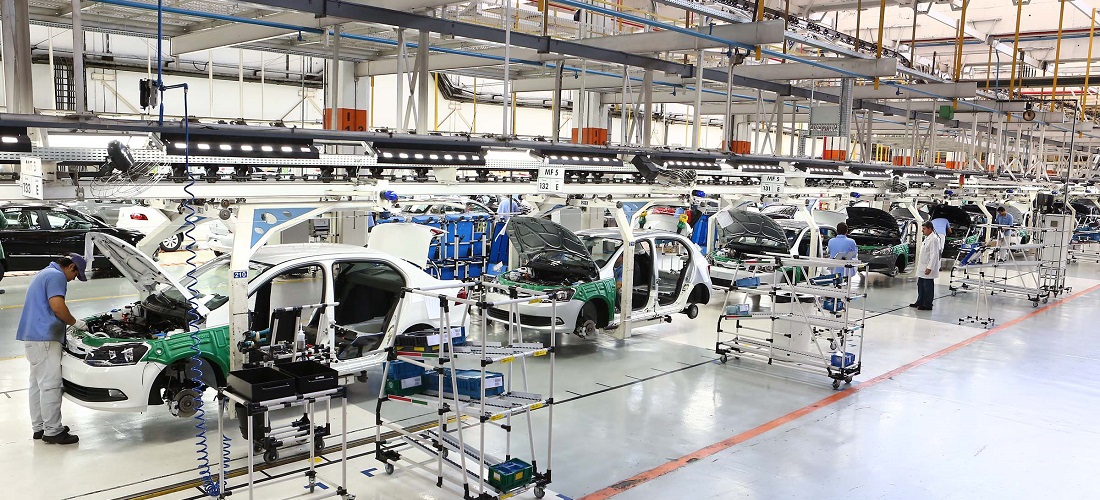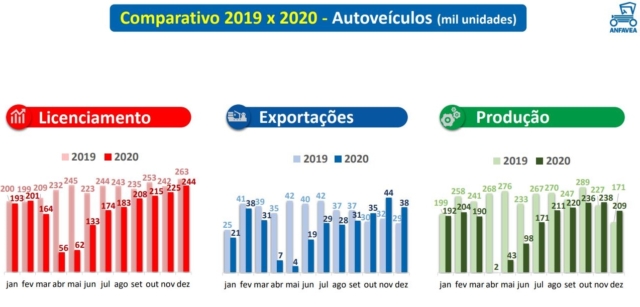
Car production falls 31.6% in 2020
Jan, 10, 2021 Posted by Ruth HollardWeek 202101
On January 8, ANFAVEA (the Brazilian association of motor-vehicle manufacturers) released the car production numbers for 2020, strongly impacted by the Covid-19 pandemic, which interrupted a three-year recovery cycle after another crisis, that of 2015/2016. The entity also released its projections for 2021, forecasting moderate growth over the previous year, but still insufficient to recover the 2019 levels.
According to ANFAVEA, December was the best in vehicle sales in the year (243,967 units), with a daily average of 11,600 units. But in comparison with 2019, only February 2020 had higher average sales, despite the market recovery seen in the second half.
The production of 209,296 units in December was a nice surprise, considering all the logistical challenges, limited inputs, and health protocols. “The industry made a great effort to meet the demand, working on weekends and suspending part of the collective vacations, but enters 2021 with the lowest inventories in its history, sufficient only for 12 days of sales”, stressed President Luiz Carlos Moraes.
Cumulative figures showed sharp declines, but not as drastic as projected at the beginning of the pandemic. The large injection of emergency resources into the economy and the strength of agribusiness helped to mitigate the losses in the second quarter when most of the factories and stores remained closed. Sales to the domestic market closed at 2,058,437 units, down 26.2%, falling back to the level of 2016, at the height of the last Brazilian economic crisis.
The production of 2,014,055 vehicles shrank 31.6%, leaving the auto industry with a technical idle of almost 3 million units. In the global ranking, Brazil should be surpassed by Spain (provisional data), falling to ninth place. Exports of 324,330 units were the worst since 2002, two decades ago. Revenue of US$ 7.4 billion was less than half of what was exported in 2017 (US $ 15.9 billion).
Driven by agribusiness and the growth of e-commerce, the truck segment had the lowest losses among vehicles, with an 11.5% drop in licensing compared to 2019. Light commercial vehicles fell 16%, automobiles fell 28.6%, and buses fell 33.4%. Agricultural and road machinery sold 7.3% more than in the previous year.
Outlook for 2021
ANFAVEA also presented its estimates for the sector this year. The entity foresees an increase of 15% in the licensing of vehicles, 9% in exports, and 25% in production, insufficient indexes for the return to 2019 pre-pandemic levels. Machine sales are expected to grow by 7%, exports by 9%, and production by 23%.
“It has never been so difficult to project annual results, as we have had a fog in front of us since March when the pandemic started”, explains Luiz Carlos Moraes. Unfortunately, we see a second wave of Covid-19 in countries in the northern hemisphere, which also seems to have arrived in Brazil. And we know that immunization with the vaccine will be a lengthy process, which will take almost the entire year, preventing a faster resumption of our economy. Add to that the pressure of costs, the urgent need for reforms, and unpleasant surprises such as the increase in the São Paulo ICMS, and we have before us a picture that still inspires great caution in our forecasts”, summarizes the President of ANFAVEA.
-
Ports and Terminals
Mar, 07, 2021
0
Turnover at Docas do Rio up 228% in January YoY
-
Jul, 29, 2021
0
Brazilian apple and sesame advance in the Indian market
-
Grains
Aug, 17, 2022
0
Brazil ships DDGS to Vietnam, exports rise as corn ethanol production booms
-
Shipping
Jan, 04, 2023
0
Paraguay River downspout nearing record lows




